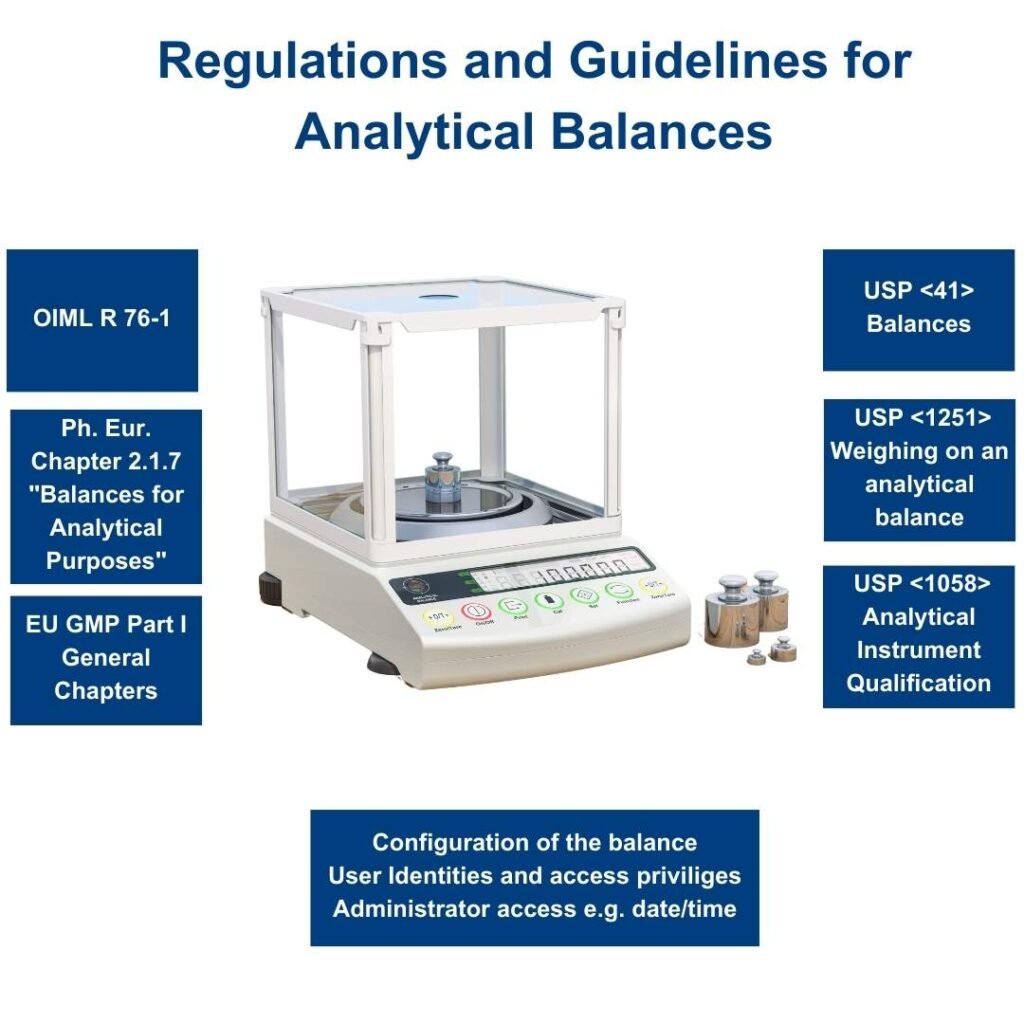The stakes are high when it comes to the precision and accuracy of measurements in Quality Control laboratories. Analytical balances are highly sensitive precision instruments capable of reliably measuring small differences in mass. Their primary function is to ensure the integrity and reliability of test results with accurate and precise weighing within a determined operating range.
This article will explore the multifaceted role of analytical balances in QC laboratories, focusing on their operational principles, key performance factors, compliance with ongoing industry standards, and the challenges and advancements shaping their use in contemporary GMP and GLP laboratory environments.
The Operating Principles of Analytical Balances
Historically, analytical balances were mechanical, employing a beam with a fixed fulcrum and pans at equal distances. The sample’s mass was determined by adding known weights to the opposite pan until equilibrium was achieved. Modern electronic balances operate based on the principle of electromagnetic force restoration, which has largely replaced mechanical ones, offering greater precision and ease of use.
Unlike mechanical balances, which require manual adjustment and are more susceptible to environmental factors, electronic balances provide automated, rapid, and precise measurements with minimal external interference. This advanced method involves using an electromagnet to generate a force that counteracts the mass of the measured sample.
When a sample is placed on the balance’s pan, it causes a displacement, which is then counterbalanced by an electromagnetic force. This force is measured and converted into a mass reading, providing highly accurate and consistent measurements.
Types of Analytical Balances Used in QC Labs

Analytical balances are classified based on their readability and minimum weight, which is directly related to the balance’s precision and accuracy. This classification is important for ensuring that the balances used in pharmaceutical settings meet the necessary standards for the specific tasks they are used for.
Class I (Ultra-Microbalances and Microbalances)
These instruments are used for the most precise measurements, such as in the weighing of reference standards and critical components of a formulation.
Ultra-Microbalances: Readability of ≤0.1 μg.
Microbalances: Readability of >0.1 μg and ≤1 μg.
Class II (Semi-Microbalances)
Semi-microbalances are used for tasks that require high precision but not to the extent of microbalances. They are suitable for standard laboratory weighing where minute quantities are involved.
Semi-microbalances: Readability of >1 μg and ≤10 μg.
Class III (Analytical Balances)
Analytical balances are the standard balances used in many laboratory settings for quantitative analysis. They offer a great balance between sensitivity and capacity.
Analytical Balances: Readability of >10 μg and ≤1 mg.
Class IV (Precision Balances)
Precision balances are less sensitive than analytical balances and are used for weighing larger quantities of substances where extremely high precision is not critical.
Precision Balances: Readability of >1 mg.
Regulations and Guidelines for Analytical Balances

In regulated industries such as pharmaceuticals, analytical balances must adhere to specific regulatory requirements to ensure compliance with Good Manufacturing Practices (GMP) and other quality standards. Here, we mention some of the organizations that provide guidance and requirements for the calibration, qualification, and operation of analytical balances:
USP
Within the United States Pharmacopeia (USP), there are several chapters that are particularly relevant to the use of analytical balances in pharmaceutical settings:
- USP Chapter <41> “Balances”: Dedicated to the proper use and calibration of balances used for quantitative determinations in pharmaceutical settings. It outlines the requirements for balance calibration, including the use of suitable weights, the frequency of calibration, and the acceptance criteria for a balance’s performance (Repeatability and Accuracy tests).
- USP Chapter <1251> “Weighing on an Analytical Balance”: Provides more detailed guidance on the use of analytical balances. It covers topics such as the different types of balances, the proper way to weigh substances on an analytical balance, factors that can affect the accuracy of a balance (like air currents, vibrations, or temperature changes), and the importance of regular calibration and maintenance.
- USP Chapter <1058> “Analytical Instrument Qualification”: Provides a framework for the qualification of analytical instruments, including analytical balances, to ensure they are suitable for their intended purposes and capable of producing reliable results.
- USP General Notices and Requirements: While not a chapter, this section provides general rules and information that apply to all USP chapters. It includes guidelines on measurement accuracy, precision, and other critical aspects that can impact the use of analytical balances.
Ph. Eur.
Concerning analytical balances, the European Pharmacopoeia (Ph. Eur.) includes specific chapters that provide guidelines and requirements for the use and qualification of balances in pharmaceutical laboratories. These chapters include:
- Ph. Eur. Chapter 2.1.7 “Balances for Analytical Purposes”: Specifically dedicated to the use of analytical balances in pharmaceutical settings (excluding balances used for manufacturing or other purposes). It outlines the requirements for balance accuracy, precision, calibration, and operation.
- Ph. Eur. General Chapters: These chapters cover the general principles of measurements and weighing techniques, which are essential for the accurate and precise use of analytical balances.
OIML
The International Organization of Legal Metrology (OIML) plays a pivotal role in the standardization and regulation of analytical balances, which are critical in various scientific and industrial applications for accurate and precise measurements. OIML provides a set of international recommendations, such as OIML R 76-1, that specify requirements for the metrological and technical aspects of balances.
These recommendations harmonize the approach to legal metrology, ensuring that equipment like analytical balances meets rigorous standards for performance and reliability.
Other International Standards and Principles
There are also other standards and principles that contribute to establishing the reliability and accuracy of analytical balances across various industries:
- ISO (International Organization for Standardization) standards, particularly ISO 17025, provide a comprehensive framework for calibration and maintenance, ensuring that laboratory instruments meet rigorous performance requirements.
- Good Laboratory Practice (GLP) principles focus on the consistent operation and integrity of analytical data, mandating regular calibration, qualification and validation of balances in non-clinical environments.
- The International Electrotechnical Commission (IEC) contributes by setting standards for electronic components of analytical balances, enhancing their functionality and safety.
- ASTM International develops consensus-based standards that include test methods and specifications applicable for the development of international standards used by individuals, companies, and governments worldwide.
Together, these organizations create a cohesive set of guidelines that ensure analytical balances are not only accurate and reliable but also meet the specific needs of diverse scientific and industrial applications.
Defining Frequency for Analytical Balance Checks
Traditionally, daily balance checks have been a common practice in quality control labs. However, a risk-based approach can help optimize routine testing and eliminate unnecessary testing, saving time and resources. The type and frequency of balance checks should be determined based on the risk and process tolerance of the application. Regular calibration, sensitivity testing, and periodic performance qualification are essential, while the frequency of other tests can be adjusted based on the specific requirements of the lab.
Factors Affecting Balance Performance and Weighing Practices

The performance of analytical balances can be influenced by various factors. This section explores the sources affecting the performance and provides recommendations for maintaining reliable measurements following best weighing practices:
Temperature Sensitivity
Fluctuations in room temperature can significantly impact the accuracy and precision of analytical balance measurements. This can lead to:
- Material Expansion and Contraction: Most materials, including those used in the construction of balances, expand when heated and contract when cooled. This dimensional change can affect the mechanical structure and alignment of the balance components, leading to measurement errors.
- Electronic Component Sensitivity: Changes in temperature can alter the electrical properties of these components, affecting the balance’s ability to measure mass accurately.
- Air Buoyancy Effect: Changes in temperature can alter the density of the air in the weighing chamber. Since the weight of an object is partly determined by the buoyant force exerted by the air around it, fluctuations in air density can cause variations in weight readings.
- Sample Stability: The temperature can also directly affect the sample being weighed. Some substances may absorb moisture or evaporate at different temperatures, leading to changes in mass.
Recommendation: Implementing strict temperature control is crucial for precise measurements.
Vibration Interference
Analytical balances, designed to measure small mass changes in the sub-milligram range, are highly sensitive to external disturbances, with vibrations being a primary source of measurement error.
Recommendation: To mitigate the impact of vibrations, analytical balances should be placed on vibration-dampening surfaces (special anti-vibration tables), isolated from potential sources of vibrations (instruments, traffic, mechanical disturbances).
Chemical Stability of Samples
Exposure to atmospheric changes (air, moisture, light, temperature variations) can cause chemical reactions, altering the sample’s state. Precautions are necessary to maintain sample integrity.
Recommendation: It’s essential to understand and control the storage and handling conditions of samples. Using appropriate containers, controlling the laboratory environment (humidity, temperature), and minimizing the time a sample is exposed to ambient conditions are key strategies.
Impact of Air Currents
Air currents from ventilation systems can affect balance mechanisms, leading to inaccurate readings. When a sample is placed on the balance, air currents can cause it to gain or lose mass artificially. For instance, a gentle breeze can add extra weight by pushing down on the sample or cause a loss in apparent weight by creating an updraft. This effect is more pronounced with lightweight or high surface area samples.
Recommendation: Controlling airflow is important for maintaining balance precision. This often involves using a balance enclosure or a draft shield to block external air currents. Proper placement of the balance away from doors, windows, and air vents is also crucial in minimizing exposure to air currents. Additionally, maintaining a stable laboratory environment with minimal temperature fluctuations and controlled HVAC systems can further reduce this problem.
Regular Calibration and Maintenance
Calibration of analytical balances is a fundamental practice in laboratories underpinning measurement accuracy, reliability, and integrity, ensuring that balances work as intended while maintaining regulatory standards.
Regular maintenance extends the lifespan of the analytical balance. It involves cleaning, lubricating, and checking for wear and tear, preventing major breakdowns and costly repairs or replacements.
Recommendation: Define regular schedules for calibration and maintenance based on the manufacturer’s recommendation and the intensity of the balance’s usage. To ensure reliable and accurate calibration, use certified and traceable weights to international standards.
User Error and Sample Handling
Users who are not properly trained in the use of an analytical balance may not understand the importance of factors like calibration, environmental conditions, and correct sample handling, leading to errors in measurement. Even minor user errors can lead to significant deviations in measurement results, compromising the reliability and validity of the data obtained.
Sample handling can significantly affect the accuracy and precision of measurements taken using an analytical balance. Here are a few key points illustrating how sample handling impacts these measurements:
- Contamination: Any residue or contaminants on the sample or container can lead to inaccurate measurements. It’s essential to ensure that both the sample and the container are clean to avoid adding extraneous weight.
- Temperature and Humidity: If a sample is warmer or cooler than the balance environment, it can affect the air density around the sample, leading to measurement errors. Likewise, high humidity can cause some materials to absorb moisture, increasing their weight. It’s important to allow samples to acclimatize to the balance environment before weighing.
- Sample Transfer: Loss of material during transfer from one container to another can result in inaccuracies. Using appropriate tools and techniques for transferring the sample can minimize material loss.
- Operator Consistency: Different handling techniques between operators, like the speed and method of placing a sample on the balance, can introduce variability. Standardizing sample handling procedures is essential for consistent results.
Recommendation: Proper training, careful handling, and adherence to laboratory standard operating procedures will minimize the impact of user error on analytical balance measurements.
Magnetic Interference
Proximity to magnetic fields can affect balances using magnetic components. Electronic analytical balances operate based on electromagnetic force restoration. This principle relies on the balance of electromagnetic forces, which can be disrupted by external magnetic fields. This can cause fluctuations in readings, gradual measurement drifts and calibration errors.
Recommendation: It’s essential to place analytical balances away from sources of magnetic interference, such as large electrical equipment, magnets, or ferromagnetic materials. Additionally, using balances with magnetic shielding or conducting regular calibration checks can help ensure the accuracy and reliability of the measurements.
Level Surface Requirements
Analytical balances are designed to operate vertically. An unleveled surface causes misalignment in the balance’s mechanical components. This misalignment can lead to uneven distribution of weight on the pan, affecting the balance’s ability to measure accurately. If the balance is not level, the force of gravity may also act unevenly across the sample, leading to incorrect readings.
Recommendation: For accurate weighing, balances must be placed on a level surface to align with gravitational forces. Regular checks with a spirit level and adjustments (if necessary) are recommended as part of the standard operating procedure for using analytical balances.
Electrical Grounding
An analytical balance, used for precise weighing in laboratories, is sensitive to even minor electrical interferences that can cause reading fluctuations. Without proper grounding, electrical noise from other equipment or environmental sources can induce small electrical currents in the balance, leading to inaccurate readings. This also poses a risk of sparks, which are potentially dangerous in environments with volatile substances.
Recommendation: Proper grounding of the AC source and balance chassis prevents static energy build-up, ensuring reliable measurements.
Use of Weighing Containers
In different situations, depending on the nature of the sample, the choice between plastic and glass containers for sample weighing can have noticeable impacts on the measurement:
- Static Electricity: Plastic containers are prone to developing static electricity, which can cause small, charged particles to either cling to or repel from the container’s surface. This static charge can lead to significant weighing errors in analytical balances. Glass, on the other hand, is less prone to static electricity, making it a more stable choice for accurate measurements.
- Weight Consistency: Glass containers are typically more uniform in weight compared to plastic containers. This uniformity is crucial for tasks requiring tare weighing, where the container’s weight is offset. Consistent weight helps in achieving more accurate and repeatable measurements.
- Tare Weight: Glass containers weigh more than plastic containers, which means they contribute to higher tare weight values. When the targeted measuring value is above the balance’s minimum weight capacity, plastic containers are preferred over glass containers.
- Chemical Resistance: Glass is generally more chemically inert compared to plastic. It does not react with chemicals or solvents used in the laboratory, ensuring no contamination or reaction that could alter the weight of the contents. Some plastics can react or absorb chemicals, leading to inaccuracies in measurements.
- Temperature Stability: Glass containers exhibit better temperature stability than plastic. They are less likely to expand or contract with temperature changes, which can affect the volume and, consequently, the weight of the contents. This property of glass makes it preferable for high-precision measurements where temperature fluctuations are a concern.
- Durability and Longevity: Glass containers are more durable and have a longer lifespan compared to plastic. They can be reused multiple times without significant wear or alteration in weight, which is essential for maintaining consistency in measurements over time.
Recommendation: Proper selection of containers for sample weighing in certain scenarios can be crucial for reliable measurements.
FAQs: Analytical Balances in QC Labs
Calibration frequency depends on usage, regulatory guidelines, and the balance’s performance history. For high-precision tasks, calibration might be necessary before each use, while less critical tasks may require less frequent calibration. Following Good Laboratory Practice (GLP) and manufacturer recommendations is essential.
Key factors include balance sensitivity, capacity, repeatability, compliance with regulatory standards (like USP), environmental adaptability, and connectivity options for data management.
Regular training of personnel, adherence to standard operating procedures (SOPs), routine calibration and maintenance, use of appropriate sample containers, and controlling lab conditions (temperature, humidity, and air currents) can significantly reduce errors.
Calibration and maintenance should be performed as per the schedule defined in your GLP protocols, with proper documentation for each activity. It’s important to use certified weights and to document all calibration procedures for audit purposes.
Use non-abrasive materials for cleaning, avoid direct contact with balance sensors, follow the manufacturer’s instructions for routine maintenance, and ensure that the balance is serviced regularly by qualified technicians.
Investigate potential causes like environmental factors, balance malfunction, or operator error. Recalibrate the balance, check for mechanical issues, and review SOPs. Also, consider filing a deviation report. If issues persist, consult the manufacturer or a professional technician.
Conclusion
Analytical balances play a vital role in quality control labs, ensuring accurate, precise and reliable weighing for various industries. Adhering to regulatory requirements, following standard operating procedures, and implementing a risk-based approach to routine testing are essential for ensuring the reliability and integrity of weighing results.
By understanding the importance of analytical balances and implementing proper weighing practices, Quality Control labs can enhance their measurement capabilities and contribute to the production of safe, effective and quality products.















